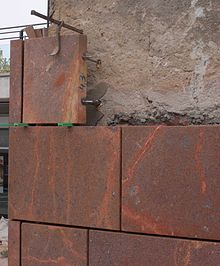Breakout load
|
|
DIN EN 13364 |
|---|---|
| Area | Construction |
| title | Testing of natural stone - determination of the breaking load at the anchor pin hole |
| Latest edition | 2002-03 |
| ISO |
The breakout load on the anchor mandrel for facade panels made of natural stone is determined by a mechanical test method using suitable test bodies . The test method applies to the execution of ventilated facades, decides on the installation options and the corresponding natural stone facade anchoring .
Anchoring options
Natural stone slabs can be anchored with dowels or anchors. An anchor consists of an anchor bar and an anchor mandrel. Four anchors usually hold a facade panel. The anchor bar is the connection to the building structure. The anchor spikes fit into the plate at a distance of one fifth of the plate edge length. The holes for the anchor pins are drilled in the center of the plate edge and the anchor pins are inserted with quick-release cement or in sliding sleeves. Usually 3, 4 and 5 centimeter thick plates are anchored.
In order to compensate for the thermal expansion of the natural stone slab, two anchor spikes on one side of the slab grip into sliding sleeves made of plastic, which are inserted into the drilled holes. The sliding sleeves are intended to compensate for the thermal rotation of the plate.
When using dowels, a distinction is made between undercut dowels and screw dowels. There are also anchors that are welded on and anchoring systems in which the plates are attached to metal rails. Anchoring with anchor spikes and cement is currently the most common method because it is the cheapest and does not require a rail system.
Rock testing
For rear-ventilated facades made of natural stone, external wall cladding is rear-ventilated according to DIN standard DIN 18516-3; Part 3: Natural stone, requirements, dimensioning to provide static proof for the breakout load at the anchor pin hole . Since natural stones, unlike many other building materials, are often very inhomogeneous and anisotropic , the technical values can fluctuate. The breakout load as a parameter is important for the use of the respective natural stone and the thickness of the natural stone slab to be selected.
To determine the breakout load according to EN 13364 , 25 millimeter long metal pins (anchor pins) are inserted in the center of a rock test body and loaded until the breakout. The force that arises when breaking out represents the respective strength value and is given in Newtons (N).
Testing institutes
In Germany, these material tests can only be carried out by approved material testing institutes and must be paid for by the respective client.
Web links
- Example of a test report for an excavation load for a sandstone (PDF; 921 kB)
- Planning and execution of facade cladding made of natural stone
- Overview of suitable natural stones for facade construction (PDF; 306 kB)
Individual evidence
- ↑ mpva.de ( page no longer available , search in web archives ) Info: The link was automatically marked as defective. Please check the link according to the instructions and then remove this notice. (PDF; 2.8 MB): Henning Rohowski: Compressive strength and breakout load newly regulated . In: Naturstein 3/2009, accessed on August 18, 2013

